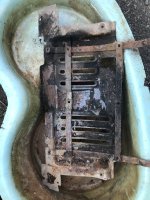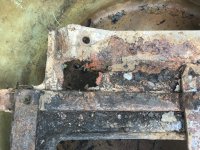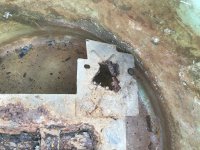The last time I priced a new sump guard with the dealer it was £175 plus vatThe attached is from another thread on this (I thought I had my own pics but maybe deleted). I would guess the main pressing is something of the order of 16s.w.g. and the two "wings" (red circles) on the front corners even thinner at 18 swg. The main weight support at the front is via hooks on the front of the subframe that locate in the slots indicated by the blue circles. The supporting rails (yellow) are probably in the order of 6mm. Apologies for mixing units but sheet thicknesses I find easier to estimate in old money...
I would say it is all weldable with MIG - a stick welder is always going to be more of a challenge but again doable with perhaps the exception of the "wings" if you stay with the original thicknesses. I agree with the snake oil comment; I purchased a sheet of stainless (304 - much cheaper than 316) with a view to reskinning the original frame but having destroyed a couple of nibbler anvils took the pragmatic view that the original lasted 10+ years therefore a replacement (especially with some additional paint from new) would outlast the car.
View attachment 446952
You are using an out of date browser. It may not display this or other websites correctly.
You should upgrade or use an alternative browser.
You should upgrade or use an alternative browser.
Technical 4x4 sump guard
- Thread starter benmac
- Start date
Currently reading:
Technical 4x4 sump guard
The Panda Nut
Nutty about Pandas Infected by Panda virus and OPD
Dont talk money be prepared too pay in body parts. Nay be a a kidney...I have been looking for aftermarket plastic under trays too,....if one is still available from Fiat, I dread to think how much money that they would want for it. I haven't got a Fiat dealer close by to go to, will pop in one next time I'm on a trip though.
abd of course standard fee of a heart. lol
WitleyPanda
Member
- Joined
- Nov 1, 2016
- Messages
- 293
- Points
- 127
The hooks just help you align/assemble but don’t actually support it, the bolts along the front lift it up from the hooks.The attached is from another thread on this (I thought I had my own pics but maybe deleted). I would guess the main pressing is something of the order of 16s.w.g. and the two "wings" (red circles) on the front corners even thinner at 18 swg. The main weight support at the front is via hooks on the front of the subframe that locate in the slots indicated by the blue circles. The supporting rails (yellow) are probably in the order of 6mm. Apologies for mixing units but sheet thicknesses I find easier to estimate in old money...
I would say it is all weldable with MIG - a stick welder is always going to be more of a challenge but again doable with perhaps the exception of the "wings" if you stay with the original thicknesses. I agree with the snake oil comment; I purchased a sheet of stainless (304 - much cheaper than 316) with a view to reskinning the original frame but having destroyed a couple of nibbler anvils took the pragmatic view that the original lasted 10+ years therefore a replacement (especially with some additional paint from new) would outlast the car.
View attachment 446952
If you can weld then 18 gauge should be easy, even with a stick welder, so long as you can turn it down, below 22 becomes a challenge
Rather than sacrificial anode, could use galvanised sheet, the zinc is the sacrificial. Plug weld it to the frame and use a zinc rich galv repair paint. Works on the farm gates. Will measure up tomorrow and decide to patch as mild steel or buy a sheet of galvanised. Nibbler would slightly wipe the edges with the zinc. If it was produced commercially in small batches, would be laser cut.
I've always questioned why those flimsy side wings are there at all? The seem to offer little in the way of protection and don't add anything in terms of support? It's as if fiat had the under trays are made before the final car was produced, at which point they found it wasn't quite wide enough...The hooks just help you align/assemble but don’t actually support it, the bolts along the front lift it up from the hooks.
If you can weld then 18 gauge should be easy, even with a stick welder, so long as you can turn it down, below 22 becomes a challengeif you go thicker then the forming becomes an issue, even if you have a fly press or similar.
Rather than sacrificial anode, could use galvanised sheet, the zinc is the sacrificial. Plug weld it to the frame and use a zinc rich galv repair paint. Works on the farm gates. Will measure up tomorrow and decide to patch as mild steel or buy a sheet of galvanised. Nibbler would slightly wipe the edges with the zinc. If it was produced commercially in small batches, would be laser cut.
..
Real answer: I guess the wing parts are made weak (ie deformable) as the chassis rails they fit to are part of the crumple zone, which can't really do its bit of absorbing impact if there's a stiff tray linking across the car.
This arrived today needs a bit of fettling but i like welding and fabrication only cost £50 so i wasn't expecting much
That looks to be in right condition and it’s a good priceThis arrived today needs a bit of fettling but i like welding and fabrication only cost £50 so i wasn't expecting much
Considering what they cost new I thought so, weld a couple plates where the rust holes are clean it up lick of paint should be good to go..That looks to be in right condition and it’s a good price
Use a good flexible weld paint/primer and top coat…I find the tractor paints are good for high build and flexibility
WitleyPanda
Member
- Joined
- Nov 1, 2016
- Messages
- 293
- Points
- 127
2012, tin worm starting to feast. Going to electrolytically strip, convert the rust, then remove the crap wing. Will cut the hole out, patch and remake new wings. Was hoping to find a suitable substitute.
Attachments
I had one the same the wings were the worst part I cut them off never replaced them they weren’t needed just like what hills hopper reported2012, tin worm starting to feast. Going to electrolytically strip, convert the rust, then remove the crap wing. Will cut the hole out, patch and remake new wings. Was hoping to find a suitable substitute.
My one has a little hole starting appear on one of the wing, it came off a 2015 cross TA 4x4 they seem to be awful for corrosion, took me ages to find one that wasn't rotted right throughI had one the same the wings were the worst part I cut them off never replaced them they weren’t needed just like what hills hopper reported
- Joined
- Sep 21, 2017
- Messages
- 936
- Points
- 301
I would say the tin worm is on desserts - that looks like the one I threw away2012, tin worm starting to feast. Going to electrolytically strip, convert the rust, then remove the crap wing. Will cut the hole out, patch and remake new wings. Was hoping to find a suitable substitute.
WitleyPanda
Member
- Joined
- Nov 1, 2016
- Messages
- 293
- Points
- 127
Threw away…… crying. Long way from scrap, even if reskinned.I would say the tin worm is on desserts - that looks like the one I threw away
- Joined
- Sep 21, 2017
- Messages
- 936
- Points
- 301
Yeah, I've a similar yard broom, had it for years, new broomstick maybe 5 years ago and a couple of new brush heads either side of that - still works a treat, good as new!Threw away…… crying. Long way from scrap, even if reskinned.
Would there be a market for this item if it were made out of a material that doesn't rust? I'm thinking carbon fibre, if you really want the next best thing when it comes to strength/bang protection? How many 4X4 owners are doing serious off roading to warrant the toughest protection though??
WitleyPanda
Member
- Joined
- Nov 1, 2016
- Messages
- 293
- Points
- 127
Carbon fibre a bit OTT and ££££, trains use polypropylene composites, for underside protection from ballast. Same material used for riot helmets. However galvanised or use of heavier gauge aluminium would suffice. Knowing what I know now, hind sight should have just stripped off when purchased the car, blasted and galvanised dipped.Would there be a market for this item if it were made out of a material that doesn't rust? I'm thinking carbon fibre, if you really want the next best thing when it comes to strength/bang protection? How many 4X4 owners are doing serious off roading to warrant the toughest protection though??
- Joined
- Sep 21, 2017
- Messages
- 936
- Points
- 301
Yep, compression moulded Twintex or similar thermoplastic composite would do it.Carbon fibre a bit OTT and ££££, trains use polypropylene composites, for underside protection from ballast. Same material used for riot helmets. However galvanised or use of heavier gauge aluminium would suffice. Knowing what I know now, hind sight should have just stripped off when purchased the car, blasted and galvanised dipped.
The properties of cf wouldn't lend themselves to that application*, based on what little I know about it. Is that fair?
*One where high impact resistance/strength is required (and a bit of 'give' would be needed too)
*One where high impact resistance/strength is required (and a bit of 'give' would be needed too)
Last edited:
- Joined
- Sep 21, 2017
- Messages
- 936
- Points
- 301
Carbon fibre(s) are exceptionally strong in tension so design has to be smart to ensure this is the "typical" loading mode. Typically folk use cf as a generic reference to a carbon fibre composite, i.e. carbon fibres and a resin (of some sort) matrix to hold the fibres together (this is the definition of a composite - a mix of different materials). This matrix has until fairly recently been, typically, a thermoset resin (usually an epoxy for high end performance) all of which, as has been observed, makes for an expensive and difficult to recycle product.The properties of cf wouldn't lend themselves to that application*, based on what little I know about it. Is that fair?
*One where high impact resistance/strength is required.
More recently carbon fibres can be formed with a thermoplastic matrix which changes the whole manufacturing process (but, again, remains expensive).
As @WitleyPanda says a thermoplastic composite (thermoplastic matrix with higher melt point thermoplastic fibres) would be more appropriate and ticks the recycling requirement box that the automotive OEMs have to (struggle) to meet these days by being recyclable while also including a percentage of recyclate.




